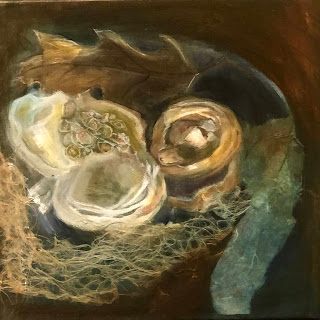 |
When I do genealogy research, I am interested in both the public and private story. To capture both, I begin with oral history and a newspaper search. Often my newspaper search reveals only the basic framework of a life. I’ve learned that to search for a woman, I need to search under her husband’s name as her given name was by no means a given. If I’m lucky, I may find a marriage announcement or an obituary. On occasion I have found more dramatic stories, bootlegging, prison sentences, love triangles. When I encounter dramatic stories, I often imagine the underlying story behind the public report.
It is through oral histories that you can capture the private story that I can only conjecture. When I suggest oral history, I am often met by the protestation that there is no one left to interview. I suggest talking to cousins as other people may have gathered those stories through conversation. And I always add, look for letters.
A story in my family is that my grandmother was shot when leaving the Ukraine. Many people left illegally as the papers to cross the border were expensive and difficult to obtain. She was believed to have traveled with her younger brother and his wife. Ultimately she ended up in a hospital in France and indeed left Europe from a French port. The brother and his wife arrived in America one week later.
Years later I took my own advice and tracked down that brother’s granddaughter. She had been close with her grandmother and heard her stories. I had first encountered her brother who ironically was a history professor. He studied royalty, but sent me on to his sister as the one who knew the family history. My newly discovered second-cousin added another thread to the story. They had to swim a river to get out. I imagined bullets flying as they swam. How she got to France is a mystery but she did indeed immigrate from France and according to my mother's report had an indentation on her arm that might have been a bullet wound.
How did I even know this story? My grandfather told me. Well not me directly. He wrote a few pages of his life history and gave it to my mother. Many years later she gave it to me, the third link in the chain. This history is what got me started in genealogy as I tried to document the story he related. It is from this history that I learned the story of my grandmother’s immigration beginning with her brother’s story.
My grandfather writes of how her brother was a revolutionary and “someone informed on him and he was caught and later pulled through the streets of the town by a very strong cord and used as an example to the people of what would happen to them if they became also revolutionaries. His parents felt that it would be better for him to go to the United States where he would stay out of trouble. So, he got married and he, his wife and my wife came to the United States of America. While crossing the border they were shot at. My wife was taken to a hospital in France, where she remained for quite a while.” High drama indeed!
My grandfather was also a letter writer and my mother moved away from New York when she married, thus the recipient of letters. Even more importantly, she kept them and ultimately shared them with me. When I began to search for my grandparents’ immigration manifests, my efforts were in vain, nothing emerged. One day I was sharing this frustration with my mother when she recalled that my grandfather had changed his name and that she had a letter that reported that. She sent me the letter where he writes it was too hard to spell so he selected a new name for this reinvention of his life. That letter led me back in time to his immigration manifest.
 |
| Donate the Knowledge 2007 S.Weinberg |
My grandfather wrote another letter that didn’t deal with his history but gave me a flavor for what he valued. My mother had returned to college as an adult and graduated with honors as a teacher. In his letter to her on this occasion, he wrote a phrase that echoed for me. “It is good to donate the knowledge to somebody else.” My grandfather closed his letter with another telling phrase. “I’m glad you could be your boss.” A tailor in the NY garment industry, he never felt that he had that control of his life. It was one of the most important things he could wish for his daughter.








